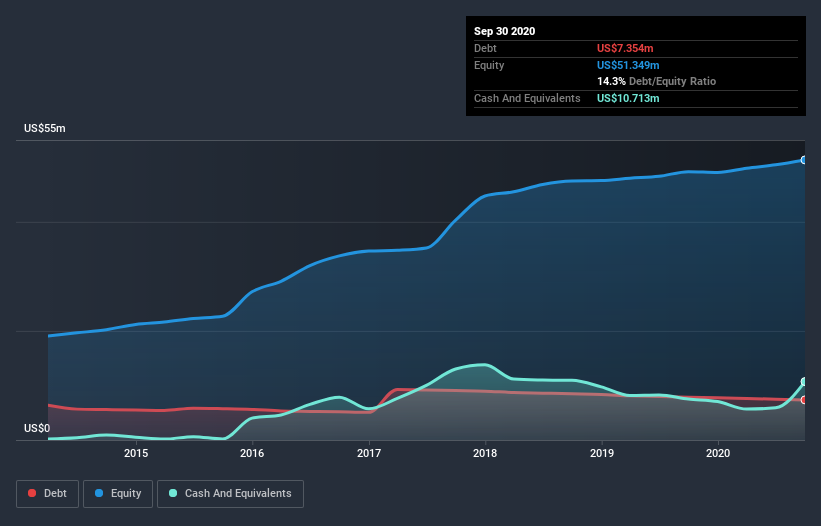- United States
- /
- Beverage
- /
- NasdaqCM:WVVI
Willamette Valley Vineyards (NASDAQ:WVVI) Seems To Use Debt Quite Sensibly

Howard Marks put it nicely when he said that, rather than worrying about share price volatility, 'The possibility of permanent loss is the risk I worry about... and every practical investor I know worries about.' When we think about how risky a company is, we always like to look at its use of debt, since debt overload can lead to ruin. We can see that Willamette Valley Vineyards, Inc. (NASDAQ:WVVI) does use debt in its business. But the real question is whether this debt is making the company risky.
When Is Debt A Problem?
Debt and other liabilities become risky for a business when it cannot easily fulfill those obligations, either with free cash flow or by raising capital at an attractive price. In the worst case scenario, a company can go bankrupt if it cannot pay its creditors. However, a more usual (but still expensive) situation is where a company must dilute shareholders at a cheap share price simply to get debt under control. Of course, the upside of debt is that it often represents cheap capital, especially when it replaces dilution in a company with the ability to reinvest at high rates of return. When we examine debt levels, we first consider both cash and debt levels, together.
Check out our latest analysis for Willamette Valley Vineyards
How Much Debt Does Willamette Valley Vineyards Carry?
The image below, which you can click on for greater detail, shows that Willamette Valley Vineyards had debt of US$7.35m at the end of September 2020, a reduction from US$7.86m over a year. But on the other hand it also has US$10.7m in cash, leading to a US$3.36m net cash position.

How Healthy Is Willamette Valley Vineyards' Balance Sheet?
Zooming in on the latest balance sheet data, we can see that Willamette Valley Vineyards had liabilities of US$10.7m due within 12 months and liabilities of US$13.2m due beyond that. Offsetting this, it had US$10.7m in cash and US$3.76m in receivables that were due within 12 months. So its liabilities outweigh the sum of its cash and (near-term) receivables by US$9.45m.
Willamette Valley Vineyards has a market capitalization of US$35.3m, so it could very likely raise cash to ameliorate its balance sheet, if the need arose. However, it is still worthwhile taking a close look at its ability to pay off debt. While it does have liabilities worth noting, Willamette Valley Vineyards also has more cash than debt, so we're pretty confident it can manage its debt safely.
Also good is that Willamette Valley Vineyards grew its EBIT at 16% over the last year, further increasing its ability to manage debt. When analysing debt levels, the balance sheet is the obvious place to start. But it is Willamette Valley Vineyards's earnings that will influence how the balance sheet holds up in the future. So when considering debt, it's definitely worth looking at the earnings trend. Click here for an interactive snapshot.
Finally, a company can only pay off debt with cold hard cash, not accounting profits. Willamette Valley Vineyards may have net cash on the balance sheet, but it is still interesting to look at how well the business converts its earnings before interest and tax (EBIT) to free cash flow, because that will influence both its need for, and its capacity to manage debt. During the last three years, Willamette Valley Vineyards burned a lot of cash. While investors are no doubt expecting a reversal of that situation in due course, it clearly does mean its use of debt is more risky.
Summing up
While Willamette Valley Vineyards does have more liabilities than liquid assets, it also has net cash of US$3.36m. And it impressed us with its EBIT growth of 16% over the last year. So we don't have any problem with Willamette Valley Vineyards's use of debt. The balance sheet is clearly the area to focus on when you are analysing debt. However, not all investment risk resides within the balance sheet - far from it. Be aware that Willamette Valley Vineyards is showing 2 warning signs in our investment analysis , and 1 of those is potentially serious...
If you're interested in investing in businesses that can grow profits without the burden of debt, then check out this free list of growing businesses that have net cash on the balance sheet.
If you’re looking to trade Willamette Valley Vineyards, open an account with the lowest-cost* platform trusted by professionals, Interactive Brokers. Their clients from over 200 countries and territories trade stocks, options, futures, forex, bonds and funds worldwide from a single integrated account. Promoted
Valuation is complex, but we're here to simplify it.
Discover if Willamette Valley Vineyards might be undervalued or overvalued with our detailed analysis, featuring fair value estimates, potential risks, dividends, insider trades, and its financial condition.
Access Free AnalysisThis article by Simply Wall St is general in nature. It does not constitute a recommendation to buy or sell any stock, and does not take account of your objectives, or your financial situation. We aim to bring you long-term focused analysis driven by fundamental data. Note that our analysis may not factor in the latest price-sensitive company announcements or qualitative material. Simply Wall St has no position in any stocks mentioned.
*Interactive Brokers Rated Lowest Cost Broker by StockBrokers.com Annual Online Review 2020
Have feedback on this article? Concerned about the content? Get in touch with us directly. Alternatively, email editorial-team (at) simplywallst.com.
About NasdaqCM:WVVI
Willamette Valley Vineyards
Produces and sells wine in the United States and internationally.
Mediocre balance sheet and slightly overvalued.
Similar Companies
Market Insights
Community Narratives




